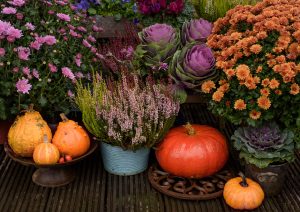Extend the season with fall flowers for your beds, borders, and containers
University of Illinois Extension Services — September 12, 2022
“When designing the garden, aim to have plants blooming continuously from spring to fall, using a variety of plant species,” says Brittnay Haag, University of Illinois Extension horticulture educator.
Fall blooming plants extend the season of our gardens after many plants have dried up or are done blooming for the year. They are also a much-needed food source for pollinators who are still foraging and getting ready for winter.
Prolong the floral show in your yard with annual or perennial plants that bloom late summer into fall, says Brittnay Haag, University of Illinois Extension horticulture educator.
“When designing the garden, aim to have plants blooming continuously from spring to fall, using a variety of plant species,” says Haag. “Perennials can be planted now, but make sure to allow at least four weeks for the roots to develop before a hard frost arrives.”
If you don’t get to it this year, make plans for next year. Perennial plants can also be planted in the spring or early summer.
Perennials with late-season blooms to add to your garden are helenium (Helenium autumnale L. var. autumnale), Joe Pye weed (Eutrochium purpureum), New England aster (Symphyotrichum novae-angliae), black-eyed Susan (Rudbeckia hirta), sedums (Sedum sp.), and Japanese anemone (Eriocapitella hupehensis). For shrub plantings, consider Rose of Sharon (Hibiscus syriacus), panicled hydrangea (Hydrangea paniculata), or Bluebeard (Caryopteris x clandonensis).
Annual plants, those completing their lifecycle in one year, can offer colorful blooms from spring until frost. Consider sprucing up your overgrown or spent-looking summer containers with a fall makeover to create a beautiful display of warm, autumnal colors.
Combine some fall blooms or foliage with existing plants that still look healthy and are blooming. Many thriller plants or focal plants such as ornamental grasses and tropicals will look great through the fall. They will add structure and height to the arrangement since many of your newly planted annuals will be shorter.
“If you plan to overwinter any of your tropical plants indoors, make sure to transplant them to a different container and move them indoors before temperatures drop below freezing,” Haag says.
Pansies (Viola sp.) can be added for a bright pop of color in any container and will have a long and late blooming season. They will do best in partly shaded areas and regular waterings. Ornamental kale and cabbage (Brassica oleracea) create a rosette of colorful and interesting foliage mixed with blooming plants. Find varieties with combinations of greens, purple and white to add to your full-sun containers. Swiss chard ‘Bright Lights’ (Beta vulgaris) is typically grown as an edible, but it is too beautiful to not include in decorative fall containers. The combination of rainbow-colored stems and glossy green foliage almost makes it look artificial.
To make your fall containers last longer, cover them with light blankets or larger containers when nighttime temperatures are below freezing. Many of the annual plants at the garden centers this time of year will survive in temperatures as low as 20°F without any damage.
For more information on plant selection or care, connect with your local Illinois Extension county office at go.illinois.edu/ExtensionOffice.







